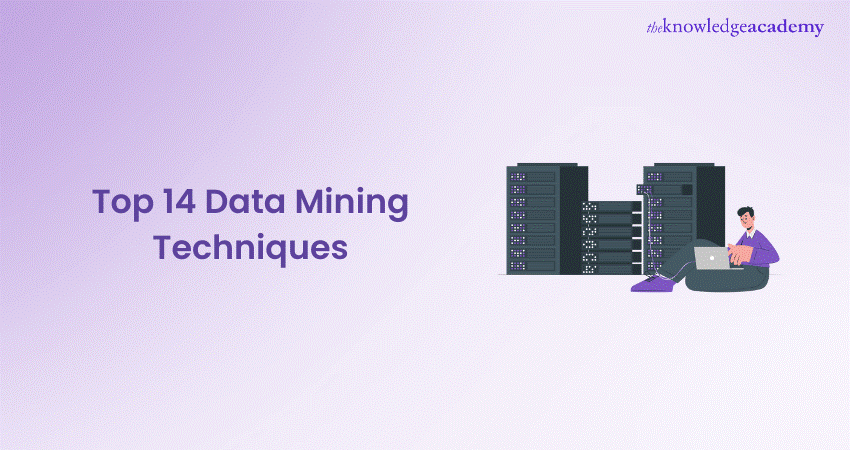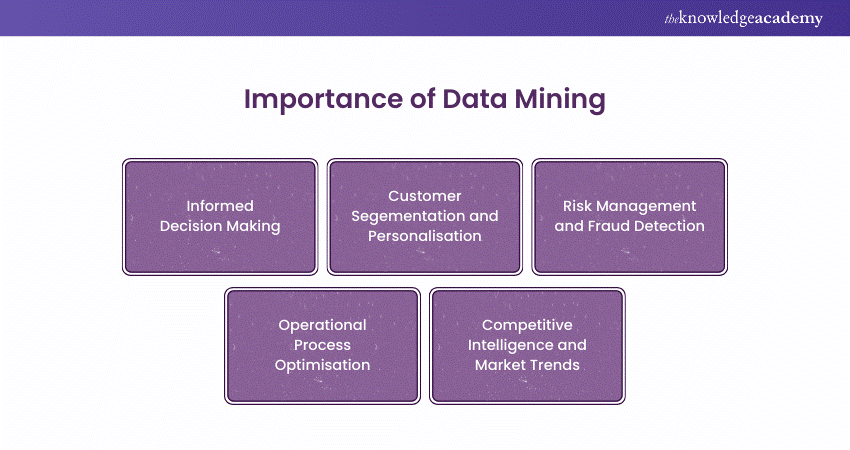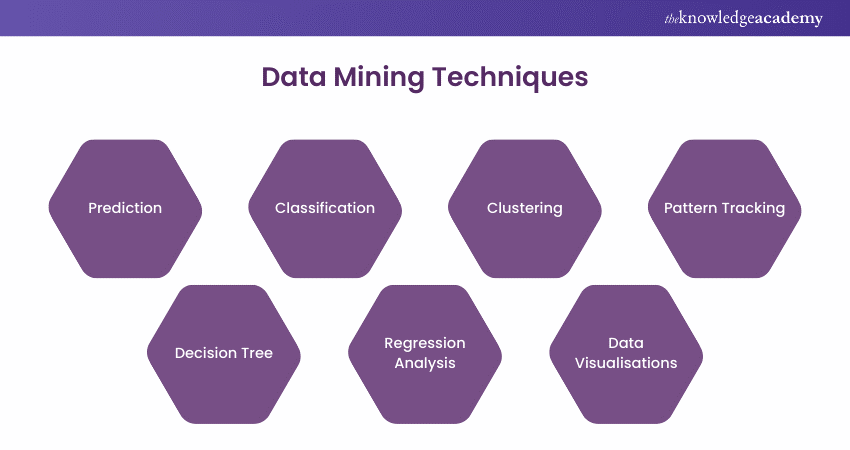We may not have the course you’re looking for. If you enquire or give us a call on + 1-866 272 8822 and speak to our training experts, we may still be able to help with your training requirements.
Training Outcomes Within Your Budget!
We ensure quality, budget-alignment, and timely delivery by our expert instructors.

In our interconnected world dominated by data, unlocking its potential has become essential. But how do we sift through this vast amount of data to find valuable insights? Enter data mining techniques, the tools that transform raw data into actionable knowledge using statistical analysis and machine learning (ML).
Join us as we embark on a journey through the realms of data mining techniques. Here, data isn't just a resource but a powerful catalyst for change—a gateway to unlocking the future. Let's explore how these techniques decipher complex data, revealing insights that shape industries and empower decision-makers worldwide.
Table of Contents
1) What is Data Mining and its importance?
2) Data Mining Techniques
a) Prediction
b) Classification
c) Clustering
d) Outlier Detection
e) Sequential Patterns
f) Regression
g) Association
h) Pattern Tracking
i) Decision Tree
j) Neural Networks
3) Conclusion
What is Data Mining and its Importance?

By analysing historical data, Data Mining helps businesses identify patterns that can inform strategic planning and improve operational efficiency. In healthcare, it aids in disease diagnosis and treatment planning by analysing patient records. In marketing, it enables targeted advertising and customer segmentation. Data Mining is a crucial tool for extracting meaningful insights from the ever-growing volume of data in today's digital age, driving innovation and efficiency across various domains.
Data Mining Techniques
Let us explore the key Data Mining Techniques, each contributing to a nuanced understanding of patterns, trends, and relationships within data.

1) Prediction
Prediction in Data Mining entails using historical data to forecast future trends. Applied across various domains, such as finance and weather forecasting, statistical algorithms analyse past patterns to predict outcomes. For instance, predicting stock prices in finance involves analysing historical market trends to anticipate future fluctuations.
Features:
a) Time series analysis
b) Trend identification
c) Regression models
d) Forecast accuracy metrics
e) Scenario analysis
2) Classification
Classification categorises data into predefined classes, a fundamental aspect of machine learning. Models are trained to assign new data points to these categories, making them invaluable for applications like spam detection. The model can accurately classify new data as spam or non-spam by discerning patterns based on previously labelled examples.
Features:
a) Model training
b) Feature selection
c) Decision boundaries
d) Confusion matrix
e) Precision-recall analysis
3) Clustering
Clustering involves grouping similar data points based on inherent patterns. It aids in uncovering structures or relationships within a dataset that might not be immediately apparent. In marketing, clustering can identify distinct customer segments with similar purchasing behaviours, enabling targeted strategies for each group.
Features:
a) Similarity metrics
b) Centroid-based clustering
c) Density-based clustering
d) Hierarchical clustering
e) Cluster validation measures
4) Outlier Detection
Outlier detection is vital for identifying anomalies or outliers within a dataset. In fraud detection, this technique helps pinpoint unusual transactions that deviate significantly from typical patterns, facilitating early detection and prevention.
Features:
a) Z-score analysis
b) Distance-based methods
c) Density-based methods
d) Isolation forests
e) Novelty detection
Uncover valuable insights from complex datasets with our Data Mining Training. Join today!
5) Sequential Patterns
Sequential patterns focus on identifying trends or patterns in a specific sequence. Analysing customer purchase sequences in retail helps understand buying behaviour and optimise product placement or promotions based on the observed order and timing of purchases.
Features:
a) Sequence mining algorithms
b) Temporal pattern recognition
c) Pattern growth methods
d) Sequential rule visualisation
e) Time series pattern analysis
6) Regression
Regression analysis assesses the relationship between variables, predicting the value of one variable based on others. In healthcare, regression can predict patient outcomes based on various medical parameters, aiding in treatment planning and resource allocation.
Features:
a) Linear regression models
b) Multiple regression
c) Polynomial regression
d) Residual analysis
e) Regression diagnostics
7) Association
Association rule mining identifies relationships or associations between variables. Applied in market basket analysis, it reveals patterns such as products frequently purchased together. Retailers leverage this information for strategic product placement and marketing.
Features:
a) Support and confidence metrics
b) Apriori algorithm
c) Fp-growth algorithm
d) Association rule visualisation
e) Rule pruning techniques
Harness the power of data to foresee future trends and outcomes with our comprehensive Predictive Analytics Course –sign up now!
8) Pattern Tracking
Pattern tracking monitors changes or trends over time. In climate analysis, for instance, tracking weather patterns helps predict long-term climate changes. In business, it aids in sales forecasting by identifying evolving consumer trends.
Features:
a) Trend analysis methods
b) Change point detection
c) Seasonal decomposition
d) Time series forecasting
e) Adaptive learning models
Elevate your text mining skills with our specialised Text Mining Training and unlock the insights hidden within textual data.
9) Decision Tree
Decision trees visually represent decision-making processes. Effective for classification tasks, they break down complex decisions into simpler ones. In customer service, a decision tree can guide support agents through troubleshooting steps and streamline issue resolution.
Features:
a) Tree-splitting criteria
b) Pruning techniques
c) Information gain
d) Gini index
e) Decision tree visualisation
10) Neural Networks
Neural networks simulate the human brain's functioning to recognise patterns. Widely used in image and speech recognition, they excel in tasks requiring learning from experience. In healthcare, neural networks can analyse medical images for disease diagnosis.
Features:
a) Layers and neuron activation
b) Backpropagation algorithm
c) Activation functions
d) Deep learning architectures
e) Transfer learning
11) Regression Analysis
Regression analysis delves into the relationship between variables, aiding in pattern identification and predictions. In finance, regression can model the impact of interest rates on investment returns, guiding investment decisions.
Features:
a) Residual analysis
b) Coefficient interpretation
c) Variable transformation
d) Heteroscedasticity testing
e) Model selection techniques
12) Processing Information in Long-term Memory
Processing information in long-term memory involves storing and retrieving information for future use. Data Mining contributes to understanding how historical data shapes current patterns, providing context for decision-making. For instance, educational analytics helps assess the long-term impact of teaching methods on student performance over successive academic years.
Features:
a) Memory storage mechanisms
b) Retrieval algorithms
c) Forgetting curve analysis
d) Memory consolidation processes
e) Context-dependent memory retrieval
13) Data Mining Analytics
At the core of data mining analytics are statistical techniques that support various analytical models. These models produce customised numerical outputs to fulfil specific business objectives. From neural networks to machine learning (ML), statistical principles drive these techniques, shaping the evolving landscape of artificial intelligence (AI).
Features:
a) Uses statistics for modelling
b) Generates tailored numerical outputs
c) Includes neural networks and machine learning (ML)
d) Advances artificial intelligence (AI)
14) Data Visualisations
Data visualisations are integral to data mining, providing insights through sensory perception. Modern visualisations, characterised by vibrant colours, excel in handling real-time streaming data. Dashboards, with varied metrics and visuals, reveal insights from data mining by vividly illustrating trends and patterns beyond numerical outputs.
Features:
a) Provides insights through senses
b) Handles real-time data with visuals
c) Uses vibrant colours for clarity
d) Highlights trends and patterns on dashboards
Boost your data analysis skills to new heights with extensive Decision Tree Modeling Using R Training!
Conclusion
Data Mining Techniques are not just tools—they're the key to unlocking insights hidden within vast datasets. These techniques empower organisations to transform raw data into strategic gold, driving innovation, efficiency, and smarter decision-making. Harnessing the power of data mining allows us to predict trends, uncover hidden patterns, and shape a smarter, more connected future.
Unlock the power of data with our comprehensive Data Science Courses and embark on a rewarding journey!
Frequently Asked Questions

The most common form of data mining is classification, which involves categorising data into predefined classes. It is widely used in various applications such as spam detection, fraud detection, and customer segmentation to make informed decisions.

The most common application of data mining is customer relationship management (CRM). It helps businesses analyse customer data to improve customer retention. Additionally, it targets marketing efforts and enhances overall customer satisfaction by identifying patterns and trends in customer behaviour.

The Knowledge Academy takes global learning to new heights, offering over 30,000 online courses across 490+ locations in 220 countries. This expansive reach ensures accessibility and convenience for learners worldwide.
Alongside our diverse Online Course Catalogue, encompassing 17 major categories, we go the extra mile by providing a plethora of free educational Online Resources like News updates, Blogs, videos, webinars, and interview questions. Tailoring learning experiences further, professionals can maximise value with customisable Course Bundles of TKA.

The Knowledge Academy’s Knowledge Pass, a prepaid voucher, adds another layer of flexibility, allowing course bookings over a 12-month period. Join us on a journey where education knows no bounds.

The Knowledge Academy offers various Data Science Courses, including Data Mining Training, Text Mining Training, Python Data Science Course and Probability And Statistics For Data Science Training. These courses cater to different skill levels, providing comprehensive insights into Data Mining Tools.
Our Data, Analytics & AI Blogs cover a range of topics related to Data Mining, offering valuable resources, best practices, and industry insights. Whether you are a beginner or looking to advance your Data Science skills, The Knowledge Academy's diverse courses and informative blogs have got you covered.







 Top Rated Course
Top Rated Course




 If you wish to make any changes to your course, please
If you wish to make any changes to your course, please


